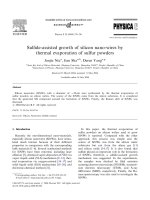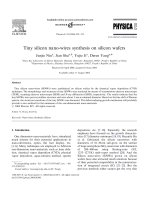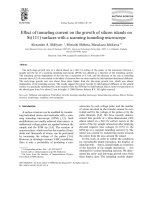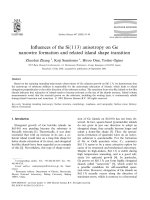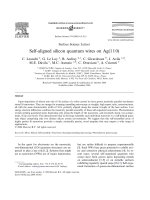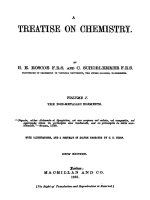- Trang chủ >>
- Khoa Học Tự Nhiên >>
- Vật lý
Tiny sio2 nano wires synthesized on si (1 1 1) wafer
Bạn đang xem bản rút gọn của tài liệu. Xem và tải ngay bản đầy đủ của tài liệu tại đây (482.79 KB, 4 trang )
Physica E 23 (2004) 1 – 4
www.elsevier.com/locate/physe
Tiny SiO
2
nano-wires synthesized on Si (1 1 1) wafer
Junjie Niu
a
, Jian Sha
a; b
, Niansheng Zhang
b
, Yujie Ji
a
, Xiangyang Ma
a
, Deren Yang
a;∗
a
State Key Lab of Silicon Materials, Department of Material Science and Engineering, Zhejiang University, Zheda Lu 38,
Hangzhou 310027, People’s Republic of China
b
Department of Physics, Zhejiang University, Hangzhou 310027, People’s Republic of China
Received 8 November 2003; accepted 27 November 2003
Abstract
Tiny SiO
2
nano-wires (SiO
2
-NWs) were synthesized on a p-Si (1 1 1) wafer by the chemical-vapor-deposition method. The
minimum diameter of the nano-wires was around 9 nm, and the length was longer than 10 m. The results of transmission
electron microscopy shows that the amorphous nano-wires were composed of Si and O with an approximate atomic ratio of
1:2. Furthermore, the photoluminescence behavior of the SiO
2
-NWs has been also checked.
? 2004 Elsevier B.V. All rights reserved.
PACS: 71.55.Cn; 81.05.Ys; 81.15.Gh
Keywords: Tiny SiO
2
nano-wires; Synthesis; PL spectrum
1. Introduction
Quasi-one dimensional nano-materials have stim-
ulated much interest for their potential applications
in nano-electronics, optics, at face display, etc.
[1–9]. Due to the requirement of the quantum con-
ÿnement eect, the diameter of the one-dimensional
nano-materials should be very small (e.g. 1 nm). It
has been reported that the minimum diameter of car-
bon tubes could be 0:4nm [10], and that of silicon
nano-wires (SiNWs) was 1 nm [11]. As an important
potential photoluminescence and wave-guide mate-
rial, silica nano-wires (SiO
2
-NWs) have attracted
attention [12]. Several techniques have been used to
fabricate SiO
2
-NWs, such as sol–gel, laser ablation,
∗
Corresponding author. Tel.: +86-571-8795-1667; fax: +86-
571-8795-2322.
E-mail address: (D. Yang).
catalyzed thermal decomposition, carbothermal re-
duction, chemical-vapor-deposition (CVD) and so on
[13–17]. By means of CVD method, it was reported
that the diameter of the SiO
2
-NWs has reached to
50 nm [18].
In this paper, we report the synthesis of the large
scale tiny (about 9 nm in diameter) and long (∼ m)
SiO
2
-NWs by a CVD process. For the consideration
of compatibility with integrated circuits, silicon sub-
strates were used in our experiments. The nano-wires
were checked by means of a scanning electron mi-
croscopy (SEM), transmission electron microscopy
(TEM), energy dispersive X-ray spectroscopy (EDX),
and photoluminescence (PL) spectroscopy.
2. Experiment
The heavily boron-doped p-type Si (1 1 1) wafers as
substrates was ÿrst cleaned for 30 min in the acetone
1386-9477/$ - see front matter ? 2004 Elsevier B.V. All rights reserved.
doi:10.1016/j.physe.2003.11.274
2 J. Niu et al. / Physica E 23 (2004) 1 – 4
by ultrasound. The substrates were about 20 mm in
width and 40 mm in length. Next, a magnetic sputter-
ing method was used to deposit Ni as a catalyst on the
substrates. Then the substrates were placed in a quartz
tube furnace. The furnace chamber was pumped down
to 10 Pa and heated. When the temperature reached
1000
◦
C, a mixture gas of argon, hydrogen, and silane
(ow ratio 100:20:15) was allowed into the chamber.
The pressure and temperature in the chamber were
kept at 2000 Pa and 1000
◦
C during the deposition.
After that, the substrates were removed from the fur-
nace for the SEM (JSM-T20, JEOL) and PL (F-4500,
Hitachi) measurement, respectively. The PL spectra
of the deposited matters on the substrates were mea-
sured at room temperature in the spectral range of
200–900 nm using a general Xe-light source with a
wavelength 206 nm as the excitation source. Further-
more, the deposited matters on the substrates were dis-
solved in an ethanol solution, and then the dropwise
was placed on a copper grid covered with a very thin
carbon ÿlm, so that the deposited materials could be
analyzed with a TEM (Phillip CM200) equipped with
an EDX.
3. Results and discussion
Top view of the large-scale entangled tiny
nano-wires synthesized on the silicon substrates is
shown in Fig. 1. The as-grown nano-wires have length
Fig. 1. Top view SEM image of the densely tiny nano-wires that
grew on a silicon substrate.
Fig. 2. TEM image of the as-grown SiO
2
-NWs. Most of the smooth
SiO
2
-NWs have uniform diameter of about 9 nm, while the others
have a diameter of 20 nm. The corresponding EDX data (upper
right inset) of the SiO
2
-NWs shows that they are composed of Si
and O with an approximate atomic ratio of 1:2. C and Cu peaks
originated from Cu grid for TEM analysis.
up to tens of micrometers, and most of them have di-
ameter around 9 nm and a few of them have diam-
eter around 20 nm, as shown in Fig. 2. The smooth
and homogeneity structure of the SiO
2
-NWs was ob-
served. The EDX spectrum (Fig. 2, upper right) shows
that the nano-wires were composed of Si and O with
an approximate atomic ratio of 1:2. C and Cu peaks
in the spectrum originated from the Cu grid used for
TEM analysis. The high-magniÿcation TEM image of
a SiO
2
-NW is given in Fig. 3. A clear Ni particle
can be seen as the catalyst attached to the tip of the
SiO
2
-NW. The SAED pattern (inset of Fig. 3) shows
no diraction spots, indicating the amorphous nature
of the SiO
2
-NW, which was of the same nature as that
in the previous work [18].
The PL measurements at an excitation wave-
length of 206 nm were carried out with a general
Xe-light source. Fig. 4 shows the PL spectrum of the
SiO
2
-NWs measured at room temperature. It reveals
a normal emission band at around 544 nm, which
is believed to be due to neutral oxygen vacancies
of SiO
2
-NWs [18,19]. Furthermore, a new emission
band at 595 nm with very weak density could be
also observed. At present, the exact mechanism of
the PL of the SiO
2
-NWs is not clear. The systemic
experiments will be needed.
According to the vapor–liquid–solid (VLS) mecha-
nism, the catalyst as islands can induce the deposition
J. Niu et al. / Physica E 23 (2004) 1 – 4 3
Fig. 3. TEM image of a single SiO
2
-NWs. A Ni–Si droplet attached
to the tip of the SiO
2
-NW (the white arrow, lower inset). The
SAED pattern in the upper right indicates the amorphous nature
of the SiO
2
-NW.
Fig. 4. PL spectrum of SiO
2
-NWs measured at room temperature.
atoms to form droplets so that nano-wires can grow
[20]. The diameter of the nanowires is dependent on
the size of the catalyst. In most of the cases these two
sizes are very close. In our experiments, the size of the
catalyst was uniform and very small (¡ 10 nm in di-
Fig. 5. The sketch graphs of the SiO
2
-NWs growth.
ameter as shown in Fig. 3). Those small catalyst par-
ticles could easily form nuclei so that the nano-wires
with smaller diameter could be grown on them.
In the beginning of the nano-wire growth, the round
Ni particle and the Si atoms deposited from silane form
a mixed Si–Ni eutectic droplet (Fig. 5a); and then
with more and more Si atoms melting, the droplets
gradually reach supersaturation. The Si atoms in the
droplet will segregate when more Si atoms joined. The
segregation has an equal probability in the 360
◦
area
around the droplets that place on the smooth silicon
substrates. Therefore, the segregated Si atoms would
grow around the droplet with the crystal directions Si
(1 1 1), Si (2 2 0), Si (3 1 1), etc. (Fig. 5b). According
to the lowest energy theory, the Si (1 1 1) direction
will dominate the ÿnal growth, for it is the lowest en-
ergy. Because the consumed Si atoms, due to the earli-
est growth of Si (1 1 1) direction, gradually to reach a
homeostasis with the deposited Si atoms, the growth of
other new Si (1 1 1) directions will not appear around
the droplet (Fig. 5c). Thus with the prolonged grow-
ing time, the Si atoms along with (1 1 1) direction con-
tinually grow to SiNWs (Fig. 5d). Here the droplet
moved forward slowly accompanying the growth of
the SiNWs. One thing must be mentioned: the newly
formed SiNWs will be oxidized rapidly to amorphous
SiO
2
by the remaining oxygen due to the low vacuum
degree and the impure reaction gases in the quartz
tube. Since the temperature (∼ 1000
◦
C) is much lower
than the crystalline temperature of the SiO
2
-NWs, this
4 J. Niu et al. / Physica E 23 (2004) 1 – 4
induces the original nano-silicon structure to an amor-
phous SiO
2
-NWs and round-belt SiO
2
structure (see
the TEM image in Fig. 3).
In the primary phase of the SiNWs, the droplets are
pushed forward slowly with the continued growth. If
only one droplet exists on the silicon wafer, the droplet
will be pushed to one direction straightly. Therefore,
the SiNWs will be uniform and straight growing under
this condition (Fig. 5d). In fact, hundreds and thou-
sands of droplets on the substrates collide unavoidably
during the co-instantaneous growth. When a moving
droplet encounters another moving droplet, the two
droplets will commix to a bigger droplet (Fig. 5e, be-
cause the outside silicon ring is very thin, we ignore
its very weak eect). When Si atoms drop in, the new
droplet will reach supersaturation again to segregate
and will keep the former SiNWs to grow continually.
But the growth velocity (Fig. 5f) has been slower in
comparison with the original SiNWs (Fig. 5c). A cer-
tain angle (in Fig. 5f) between the two dierent di-
rectional SiNWs induces the SiNWs to grow curly (see
Fig. 5g). The SiNWs formed under this condition are
commonly curving (see the circular regions in Fig. 2).
Obviously, the number of commixed SiNWs droplets
is very small. Even the encountering of three or more
than three droplets is much less (Fig. 5h). The major-
ity is that one droplet forms a SiNW and its diameter
is relatively straight, as shown Fig. 2. A deeper under-
standing of the growth mechanism of the SiO
2
-NWs
might contribute to the successful synthesis and de-
vice application of one-dimensional quantum wires.
4. Conclusions
Tiny SiO
2
nano-wires with a minimum diameter of
about 9 nm and a length of more than 10 m were
synthesized on a p-Si (1 1 1) wafer. The experiments
of SEM and TEM found that nano-wires were com-
posed of Si and O with an approximate atomic ratio
of 1:2 and were of amorphous nature. Besides the nor-
mal emission band at 544 nm, a new weak emission
peak at 595 nm in the PL spectrum of SiO
2
-NWs was
also observed.
Acknowledgements
This work was supported by the National Natu-
ral Science Foundation of China (No. 50272057 and
60225010) and Zhejiang Provincial Natural Science
Foundation (No. 601092). The authors also express
their gratitude to Prof. Youwen Wang for the TEM
measurement.
References
[1] D.D.D. Ma, C.S. Lee, Y. Lifshitz, S.T. Lee, Appl. Phys. Lett.
81 (2002) 3233.
[2] S. Nihonyanagi, Y. Kanemitsa, Physica E 17 (2003) 183.
[3] J.J. Niu, J. Sha, Y.W. Wang, X.Y. Ma, D.R. Yang,
Microelectron. Eng. 66 (2003) 65.
[4] D.P. Yu, Y.J. Xing, Q.L. Hang, H.F. Yan, J. Xu, Z.H. Xi,
S.Q. Feng, Physica E 9 (2001) 305.
[5] J. Sha, J.J. Niu, X.Y. Ma, J. Xu, X.B. Zhang, Q. Yang, D.R.
Yang, Adv. Mater. 14 (2002) 1219.
[6] J.J. Niu, J. Sha, X.Y. Ma, J. Xu, D.R. Yang, Chem. Phys.
Lett. 367 (2003) 528.
[7] H. Zhang, X.Y. Ma, J. Xu, J.J. Niu, J. Sha, D.R. Yang,
J. Cryst. Growth 246 (2002) 108.
[8] T.I. Kamins, R. Stanley Williams, T. Hesjedal, J.S. Harris,
Physica E 13 (2002) 995.
[9] Y. Cui, C.M. Lieber, Science 291 (2001) 851.
[10] N. Wang, Z.K. Tang, G.D. Li, J.S. Chen, Nature 408 (2000)
50.
[11] D.D.D. Ma, C.S. Lee, F.C.K. Au, S.Y. Tong, S.T. Lee,
Science 299 (2003) 1874.
[12] D.P. Yu, Q.L. Hang, Y. Ding, H.Z. Zhang, Z.G. Bai,
J.J. Wang, Y.H. Zou, Appl. Phys. Lett. 73 (1998) 3076.
[13] M. Zhang, Y. Bando, K. Wada, K. Kubashima, J. Mater. Sci.
Lett. 18 (1999) 1911.
[14] M. Zhang, Y. Bando, K. Wada, J. Mater. Res. 15 (2000) 387.
[15] Z.Q. Liu, S.S. Xie, L.F. Sun, D.S. Tang, W.Y. Zhou, C.Y.
Wang, W. Liu, Y.B. Li, X.P. Zou, G. Wang, J. Mater. Res.
16 (2001) 683.
[16] J.C. Wang, G.Z. Zhan, F.G. Li, Solid State Commun. 125
(2003) 629.
[17] Z.W. Pan, Z.R. Dai, C. Ma, Z.L. Wang, J. Am. Chem. Soc.
124 (2002) 1817.
[18] J.Q. Hu, Y. Jiang, X.M. Meng, C.S. Lee, S.T. Lee, Chem.
Phys. Lett. 367 (2003) 339.
[19] H. Nishikawa, T. Shiroyama, R. Nakamura, Y. Ohiki,
K. Nagaswa, Y. Hama, Phys. Rev. B 45 (1992) 586.
[20] R.S. Wangner, W.C. Ellis, Appl. Phys. Lett. 4 (1964) 89.



